A Fiber Ring Laser Sensor with a Side Polished Evanescent Enhanced Fiber for Highly Sensitive Temperature Measurement
Abstract
1. Introduction
2. Working Principle
3. Experimental Results and Discussion
4. Conclusions
Author Contributions
Funding
Conflicts of Interest
References
- Zhang, W.; Webb, D.J.; Lao, L.Y.; Hammond, D.; Carpenter, M.; Williams, C. Water content detection in aviation fuel by using PMMA based optical fiber grating. Sens. Actuators B Chem. 2019, 282, 774–779. [Google Scholar] [CrossRef]
- Wang, G.Y.; Lu, Y.; Duan, L.C.; Yao, J.Q. A Refractive Index Sensor Based on PCF With Ultra-Wide Detection Range. IEEE J. Sel. Top. Quant. 2021, 27, 1–8. [Google Scholar] [CrossRef]
- Chen, C.; Wang, J. Optical biosensors: An exhaustive and comprehensive review. Analyst 2020, 145, 1605–1628. [Google Scholar] [CrossRef] [PubMed]
- Floris, I.; Adam, J.M.; Calderon, P.A.; Sales, S. Fiber Optic Shape Sensors: A comprehensive review. Opt. Lasers Eng. 2021, 139, 106508. [Google Scholar] [CrossRef]
- Li, W.C.; Yuan, Y.G.; Yang, J.; Yuan, L.B. Review of Optical Fiber Sensor Network Technology Based on White Light Interferometry. Photonic Sens. 2021, 11, 31–44. [Google Scholar] [CrossRef]
- Liu, Y.C.; Mataira, R.; Badcock, R.; Jiang, Z.N.; Fang, J. Application of Epoxy-Bonded FBG Temperature Sensors for High-Temperature Superconductor-Coated Conductor Quench Detection. IEEE Tran. Appl. Supercon. 2021, 31, 1–8. [Google Scholar] [CrossRef]
- Yang, W.; Li, C.; Wang, M.; Yu, X.; Fan, J.; Xiong, Y.; Yang, Y.; Li, L. The Polydimethylsiloxane Coated Fiber Optic for All Fiber Temperature Sensing Based on the Multithin–Multifiber Structure. IEEE Sens. J. 2021, 21, 51–56. [Google Scholar] [CrossRef]
- Lee, B.H.; Kim, Y.H.; Park, K.S.; Eom, J.B.; Kim, M.J.; Rho, B.S.; Choi, H.Y. Interferometric fiber optic sensors. Senors 2012, 12, 2467–2486. [Google Scholar] [CrossRef]
- Wen, J.-H.; Wang, J.; Yang, L.; Hou, Y.-F.; Huo, D.-H.; Cai, E.-L.; Xiao, Y.-X.; Wang, S.-S. Response Time of Microfiber Temperature Sensor in Liquid Environment. IEEE Sens. J. 2020, 20, 6400–6407. [Google Scholar] [CrossRef]
- Cheng, Y.; Wang, Y.; Song, Z.; Lei, J. High-sensitivity optical fiber temperature sensor based on a dual-loop optoelectronic oscillator with the Vernier effect. Opt. Express 2020, 28, 35264–35271. [Google Scholar] [CrossRef]
- Ren, X.; Gao, J.; Shi, H.; Huang, L.; Zhao, S.; Xu, S. A highly sensitive all-fiber temperature sensor based on the enhanced green upconversion luminescence in Lu2MoO6:Er3+/Yb3+ phosphors by co-doping Li+ ions. Optik 2021, 227, 166084. [Google Scholar] [CrossRef]
- Nan, T.; Liu, B.; Wu, Y.; Wang, J.; Mao, Y.; Zhao, L.; Sun, T.; Wang, J. Optical fiber temperature sensor with insensitive refractive index and strain based on phase demodulation. Microw. Opt. Technol. Lett. 2020, 62, 3733–3738. [Google Scholar] [CrossRef]
- Xu, Y.; Chen, X.; Zhu, Y. High Sensitive Temperature Sensor Using a Liquid-core Optical Fiber with Small Refractive Index Difference Between Core and Cladding Materials. Sensors 2008, 8, 1872–1878. [Google Scholar] [CrossRef]
- Xu, B.; Li, J.; Li, Y.; Xie, J.; Dong, X. Ultrasensitive Temperature Sensor Based on Refractive Index Liquid-Sealed Thin-Core Fiber Modal Interferometers. IEEE Sens. J. 2014, 14, 1179–1184. [Google Scholar] [CrossRef]
- Ma, J.; Wu, S.; Cheng, H.; Yang, X.; Wang, S.; Lu, P. Sensitivity-enhanced temperature sensor based on encapsulated S-taper fiber Modal interferometer. Opt. Laser Technol. 2021, 139, 106933. [Google Scholar] [CrossRef]
- Wang, Y.J.; Li, S.G.; Wang, M.Y.; Yu, P.T. Refractive index sensing and filtering characteristics of side-polished and gold-coated photonic crystal fiber with a offset core. Opt. Laser Technol. 2021, 136, 106759. [Google Scholar] [CrossRef]
- Caucheteur, C.; Guo, T.; Albert, J. Review of plasmonic fiber optic biochemical sensors: Improving the limit of detection. Anal Bioanal. Chem. 2015, 407, 3883–3897. [Google Scholar] [CrossRef] [PubMed]
- Yang, X.; Bandyopadhyay, S.; Shao, L.-Y.; Xiao, D.; Gu, G.; Song, Z. Side-Polished DBR Fiber Laser with Enhanced Sensitivity for Axial Force and Refractive Index Measurement. IEEE Photonics J. 2019, 11, 1–10. [Google Scholar] [CrossRef]
- Weng, S.; Pei, L.; Wang, J.; Ning, T.; Li, J. High sensitivity D-shaped hole fiber temperature sensor based on surface plasmon resonance with liquid filling. Photonics Res. 2017, 5, 103–107. [Google Scholar] [CrossRef]
- Dong, Y.; Wu, B.; Wang, M.; Xiao, H.; Xiao, S.; Sun, C.; Li, H.; Jian, S. Magnetic field and temperature sensor based on D-shaped fiber modal interferometer and magnetic fluid. Opt. Laser Technol. 2018, 107, 169–173. [Google Scholar] [CrossRef]
- Liu, X.; Zhang, X.; Yang, J.; Du, X. Dual-ring dual-wavelength fiber laser sensor for simultaneous measurement of refractive index and ambient temperature with improved discrimination and detection limit. Appl. Opt. 2019, 58, 7582–7587. [Google Scholar] [CrossRef]
- Han, M.; Liu, T.; Hu, L.; Zhang, Q. Intensity-demodulated fiber-ring laser sensor system for acoustic emission detection. Opt. Express 2013, 21, 29269–29276. [Google Scholar] [CrossRef] [PubMed]
- Shao, L.Y.; Liang, J.W.; Zhang, X.P.; Pan, W.; Yan, L.S. High-Resolution Refractive Index Sensing With Dual-Wavelength Fiber Laser. IEEE Sens. J. 2016, 16, 8463–8467. [Google Scholar] [CrossRef]
- Prerana, P.; Varshney, R.K.; Pal, B.P.; Nagaraju, B. High Sensitive Fiber Optic Temperature Sensor Based on a Side-polished Single-mode Fiber Coupled to a Tapered Multimode Overlay Waveguide. J. Opt. Soc. Korea 2010, 14, 337–341. [Google Scholar] [CrossRef]
- He, C.; Fang, J.; Zhang, Y.; Yang, Y.; Yu, J.; Zhang, J.; Guan, H.; Qiu, W.; Wu, P.; Dong, J.; et al. High performance all-fiber temperature sensor based on coreless side-polished fiber wrapped with polydimethylsiloxane. Opt. Express 2018, 26, 9686–9699. [Google Scholar] [CrossRef] [PubMed]
- Liu, S.; Cao, S.; Zhang, Z.; Wang, Y.; Liao, C.; Wang, Y. Temperature Sensor Based on Side-Polished Fiber SPR Device Coated with Polymer. Sensors 2019, 19, 4063. [Google Scholar] [CrossRef]
- An, G.; Li, S.; Qin, W.; Zhang, W.; Fan, Z.; Bao, Y. High-Sensitivity Refractive Index Sensor Based on D-Shaped Photonic Crystal Fiber with Rectangular Lattice and Nanoscale Gold Film. Plasmonics 2014, 9, 1355–1360. [Google Scholar] [CrossRef]
- Chen, A.; Yu, Z.; Dai, B.; Li, Y. Highly Sensitive Detection of Refractive Index and Temperature Based on Liquid-Filled D-Shape PCF. IEEE Photonics Technol. Lett. 2021, 33, 529–532. [Google Scholar] [CrossRef]
- Dong, Y.; Xiao, S.; Xiao, H.; Liu, J.; Sun, C.; Jian, S. An Optical Liquid-Level Sensor Based on D-Shape Fiber Modal Interferometer. IEEE Photonics Technol. Lett. 2017, 29, 1067–1070. [Google Scholar] [CrossRef]
- Tan, R.X.; Ho, D.; Tse, C.H.; Tan, Y.C.; Yoo, S.W.; Tjin, S.C.; Ibsen, M. Birefringent Bragg Grating in C-Shaped Optical Fiber as a Temperature-Insensitive Refractometer. Sensors 2018, 18, 3285. [Google Scholar] [CrossRef]
- Dong, Y.; Xiao, S.Y.; Wu, B.L.; Xiao, H.; Jian, S.S. Refractive Index and Temperature Sensor Based on D-Shaped Fiber Combined With a Fiber Bragg Grating. IEEE Sens. J. 2019, 19, 1362–1367. [Google Scholar] [CrossRef]
- Sun, M.; Jin, Y.; Dong, X. All-Fiber Mach–Zehnder Interferometer for Liquid Level Measurement. IEEE Sens. J. 2015, 15, 3984–3988. [Google Scholar] [CrossRef]
- Geng, T.; He, J.; Yang, W.L.; Chen, X.D.; An, M.W.; Sun, C.T.; Jin, X.R.; Yuan, L.B. Modal Interferometer Using Three-Core Fiber for Simultaneous Measurement Strain and Temperature. IEEE Photonics J. 2016, 8, 1–8. [Google Scholar] [CrossRef]
- Madry, M.; Alwis, L.; Binetti, L.; Pajewski, L.; Beres-Pawlik, E. Simultaneous Measurement of Temperature and Relative Humidity Using a Dual-Wavelength Erbium-Doped Fiber Ring Laser Sensor. IEEE Sens. J. 2019, 19, 9215–9220. [Google Scholar] [CrossRef]
- Wu, Z.; Zhang, H.; Shum, P.P.; Shao, X.; Huang, T.; Seow, Y.M.; Liu, Y.G.; Wei, H.; Wang, Z. Supermode Bragg grating combined Mach-Zehnder interferometer for temperature-strain discrimination. Opt. Express 2015, 23, 33001–33007. [Google Scholar] [CrossRef]
- Gan, L.; Wang, R.X.; Liu, D.M.; Duan, L.; Liu, S.; Fu, S.N.A.; Li, B.R.; Feng, Z.H.; Wei, H.F.; Tong, W.J.; et al. Spatial-Division Multiplexed Mach-Zehnder Interferometers in Heterogeneous Multicore Fiber for Multiparameter Measurement. IEEE Photonics J. 2016, 8, 1–8. [Google Scholar] [CrossRef]
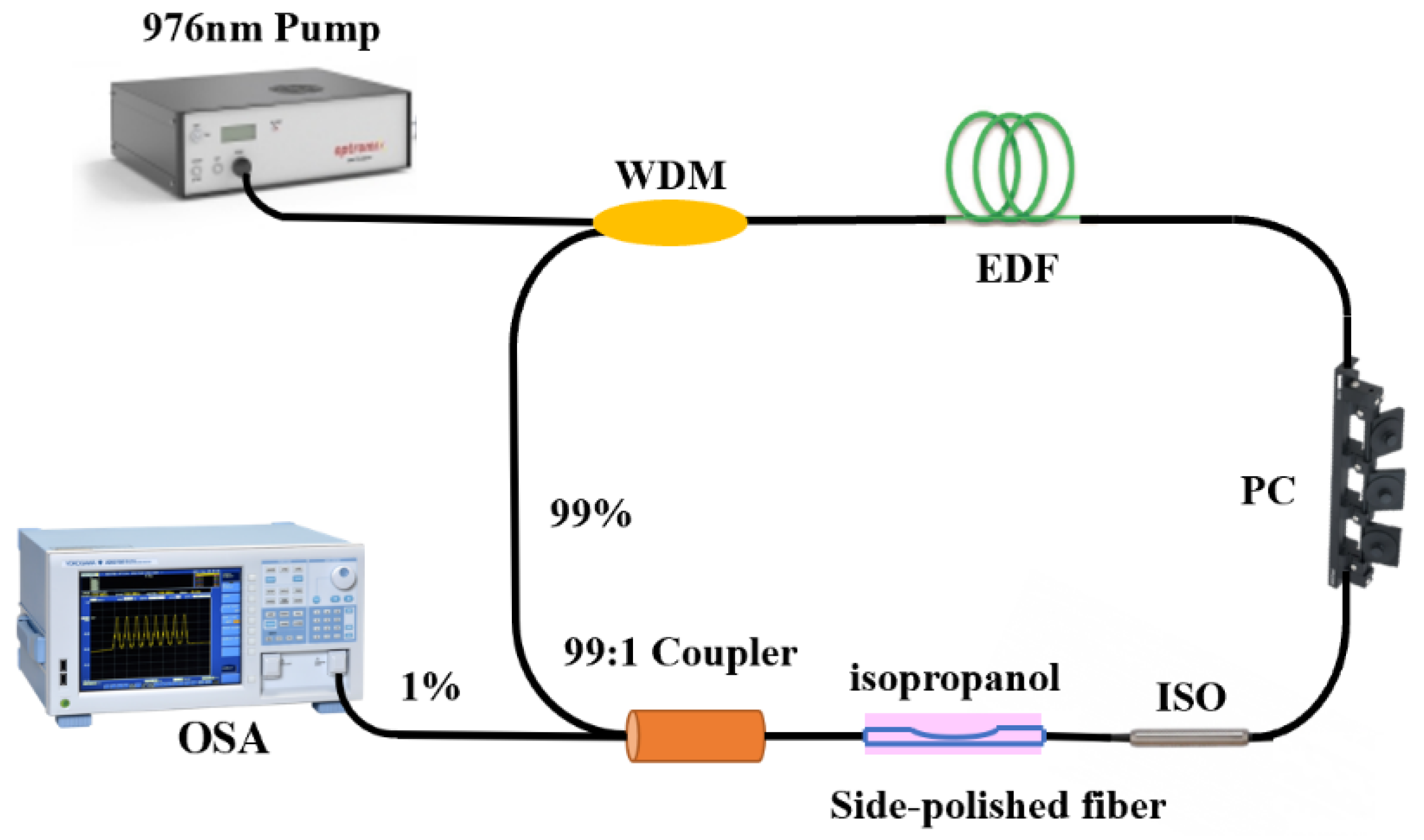

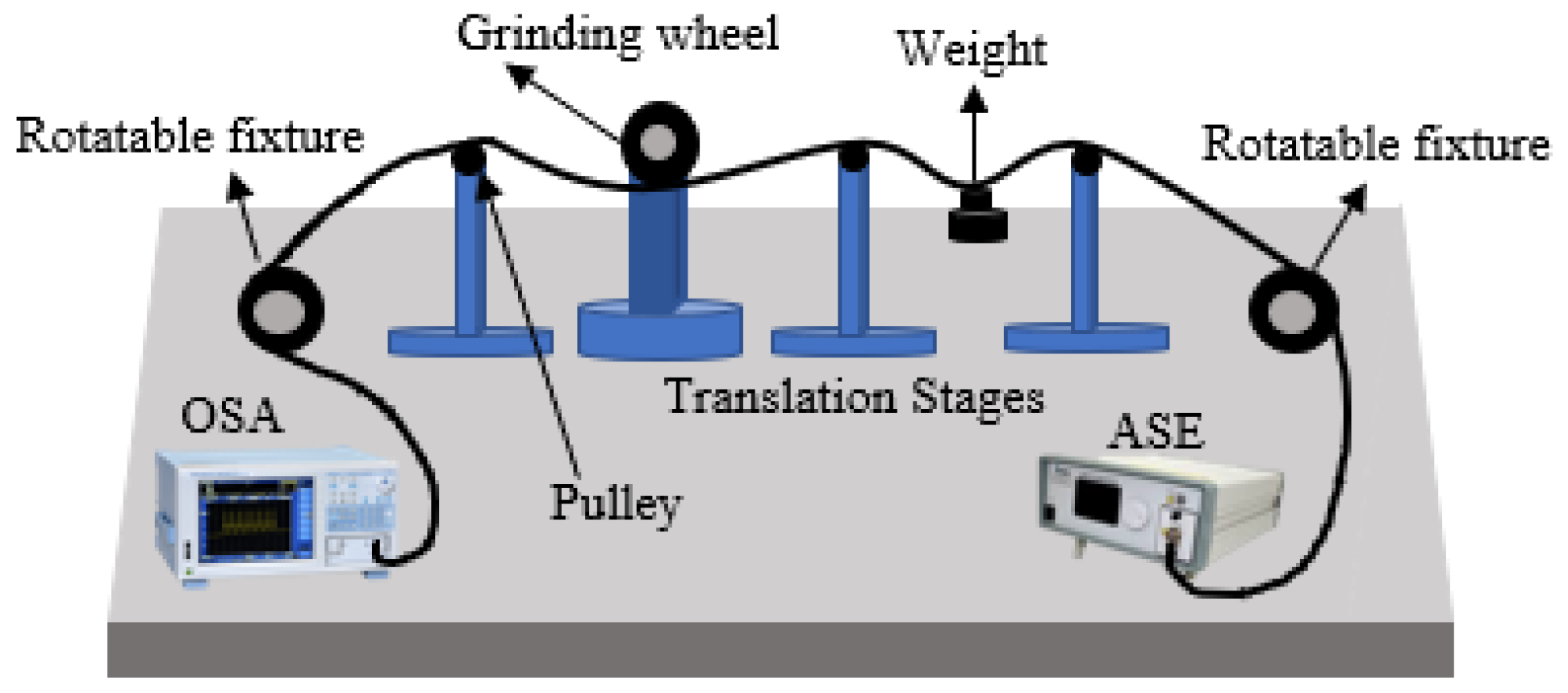

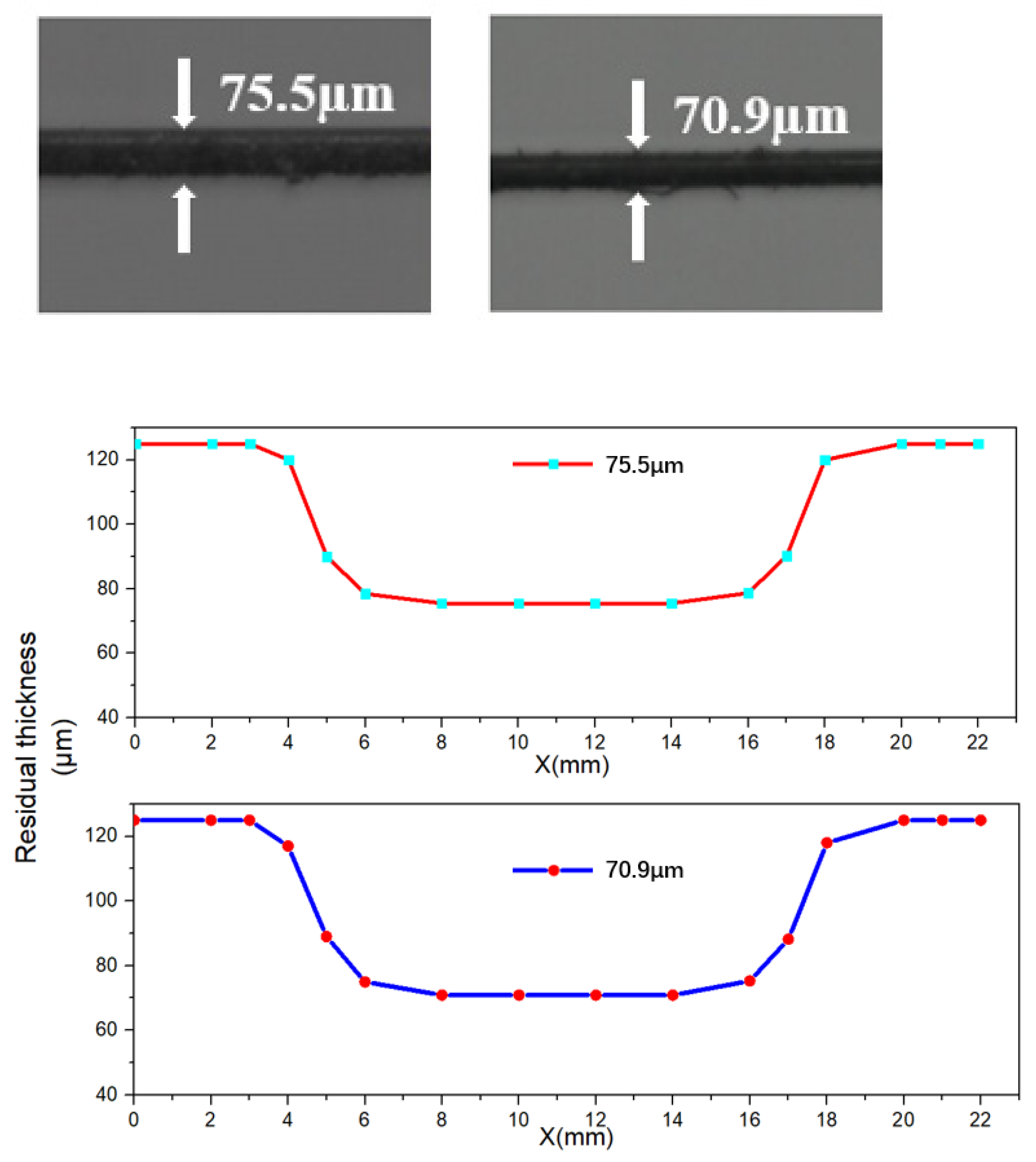
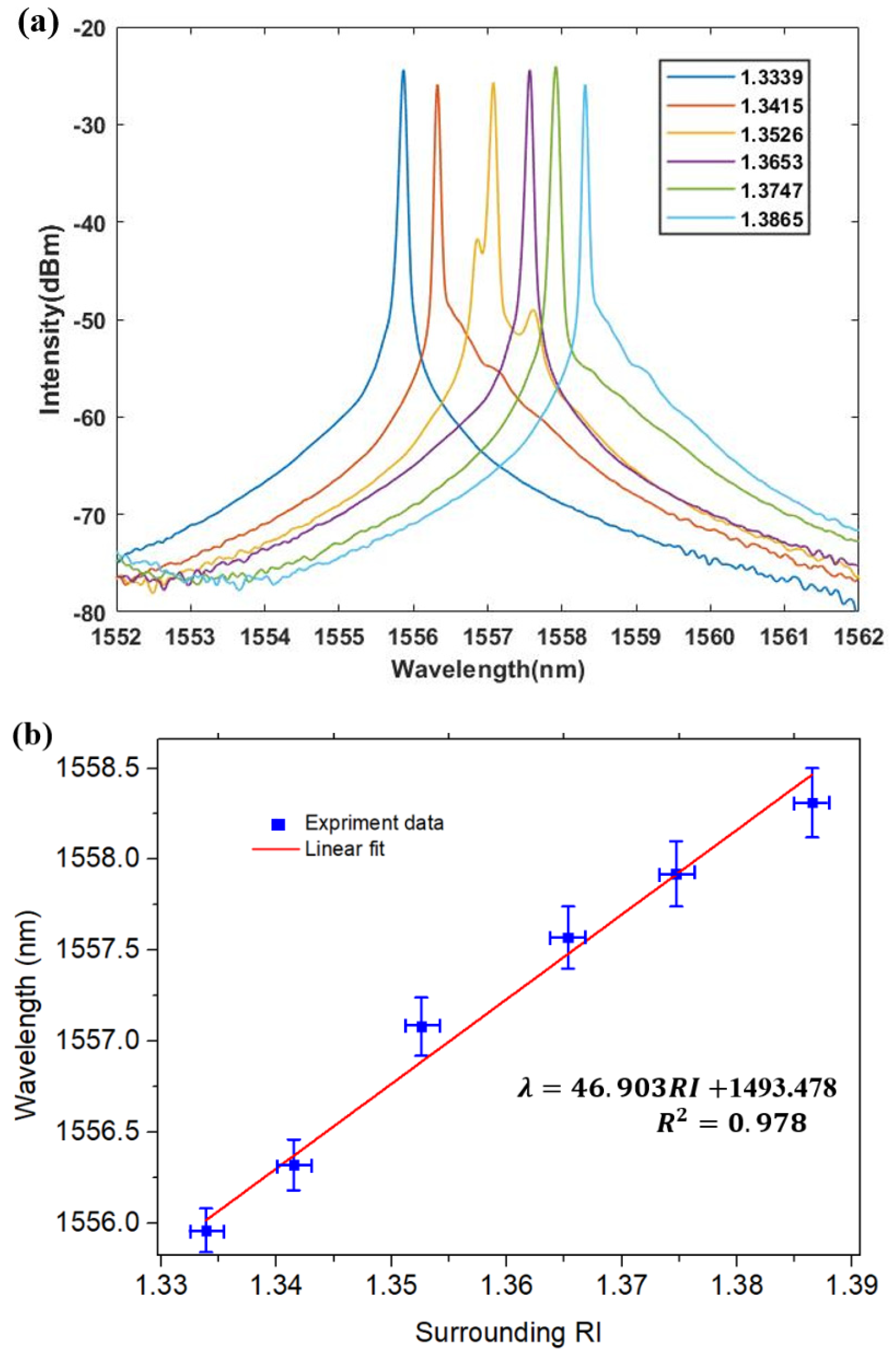

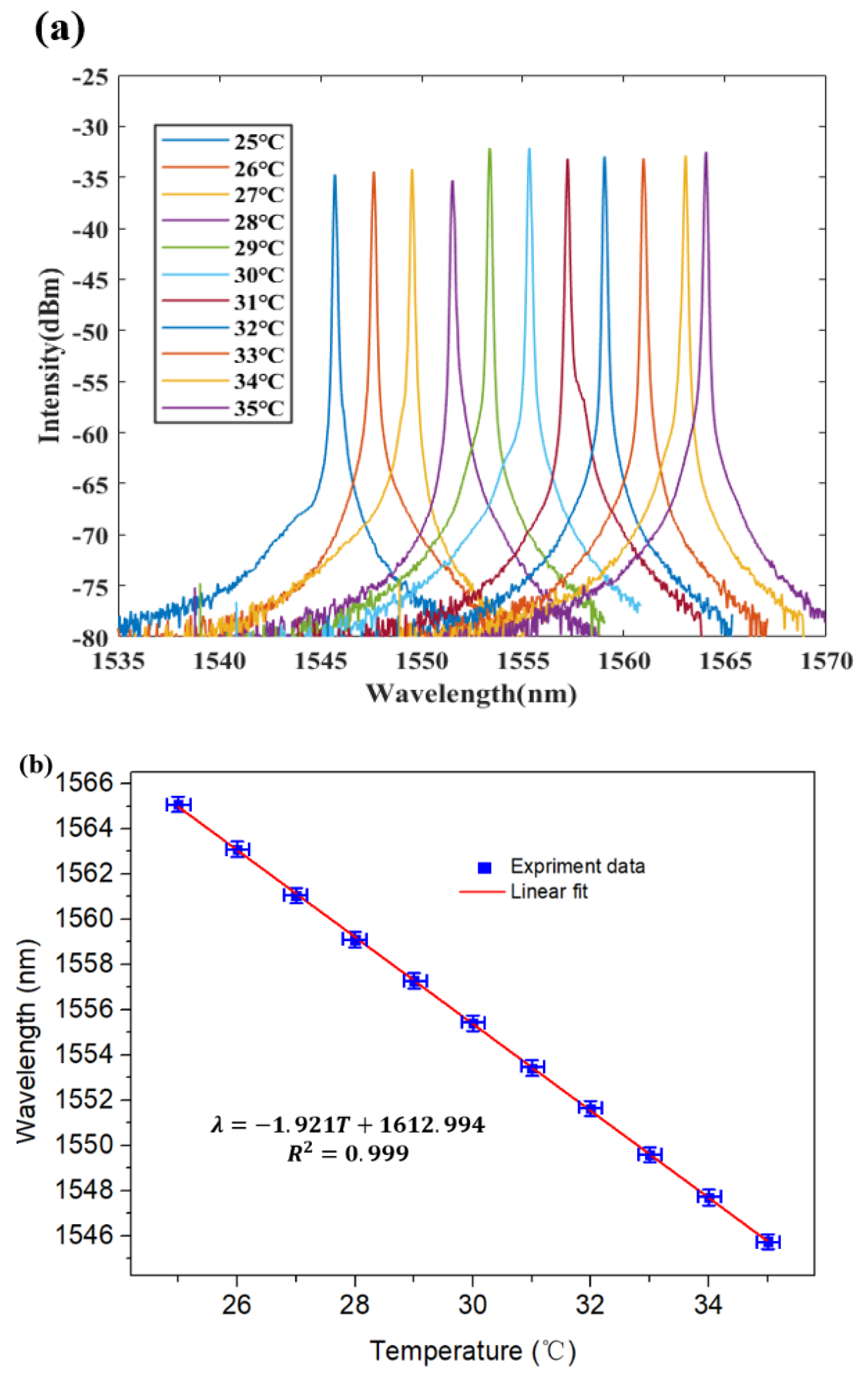

Publisher’s Note: MDPI stays neutral with regard to jurisdictional claims in published maps and institutional affiliations. |
© 2021 by the authors. Licensee MDPI, Basel, Switzerland. This article is an open access article distributed under the terms and conditions of the Creative Commons Attribution (CC BY) license (https://creativecommons.org/licenses/by/4.0/).
Share and Cite
Lin, W.; Liu, Y.; Shao, L.; Vai, M.I. A Fiber Ring Laser Sensor with a Side Polished Evanescent Enhanced Fiber for Highly Sensitive Temperature Measurement. Micromachines 2021, 12, 586. https://doi.org/10.3390/mi12050586
Lin W, Liu Y, Shao L, Vai MI. A Fiber Ring Laser Sensor with a Side Polished Evanescent Enhanced Fiber for Highly Sensitive Temperature Measurement. Micromachines. 2021; 12(5):586. https://doi.org/10.3390/mi12050586
Chicago/Turabian StyleLin, Weihao, Yibin Liu, Liyang Shao, and Mang I. Vai. 2021. "A Fiber Ring Laser Sensor with a Side Polished Evanescent Enhanced Fiber for Highly Sensitive Temperature Measurement" Micromachines 12, no. 5: 586. https://doi.org/10.3390/mi12050586
APA StyleLin, W., Liu, Y., Shao, L., & Vai, M. I. (2021). A Fiber Ring Laser Sensor with a Side Polished Evanescent Enhanced Fiber for Highly Sensitive Temperature Measurement. Micromachines, 12(5), 586. https://doi.org/10.3390/mi12050586






